Unlock the potential of your garden with the ideal companion plants for peas. If you’re a pea enthusiast, knowing which plants can thrive alongside your peas can significantly enhance your gardening experience.
In this modern age of abundant information, we’re here to share the best and worst companions for peas, sparing you the trial and error. This article will provide insights into the most compatible plants for peas, helping you leverage nature’s own gardening solutions and steer clear of any pitfalls.
Embarking on this journey is not only enjoyable and rewarding but also simpler than you might imagine. Join us as we delve into the world of companion plants for peas and equip you with the necessary knowledge!
Table of Contents
The best companion plants for peas
Companion planting really is the next step in taking your garden to the next level. Some companion plants will help to protect your peas by repelling pests, for instance, while others improve the soil, providing living mulch or ground cover to keep away weeds.
Once you’ve gotten pairing down, you can even try adding more plants so that your garden has layers of perks and defense in the form of the plants you’ve chosen, working together in harmony with Nature.
In the sections below, we’ll tell you a little about each plant, so that you know what perks they’ll offer your peas, and we’ll include their favorite soil types, how much sun they need, and more. Once we’re done with the ‘good’ companions, then we’ll share some ‘bad companions’ so that you’ll know what to avoid and why.
To keep things interesting, we’ll give you a variety of plant types, including kitchen and medicinal herbs, healthy veggies and delicious fruits, and ornamental additions, so that there’s a little something for everyone. Without further ado – let’s look at those companions!
Kitchen and medicinal herbs
1. Mint
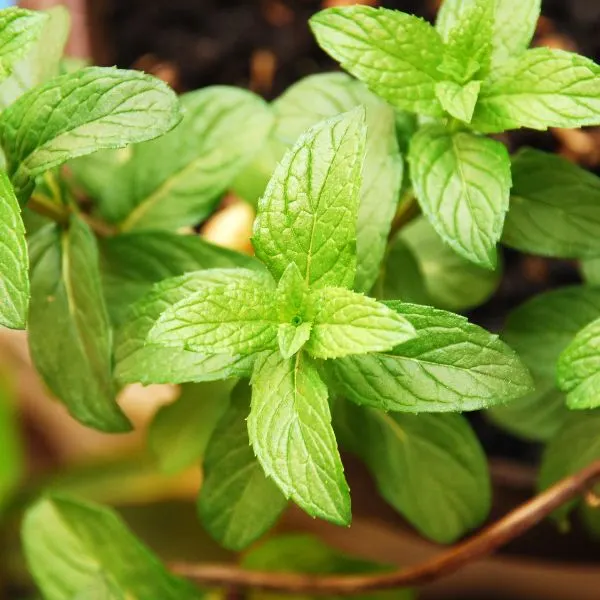
- Botanical name: Mentha
- Sun Requirements: Full sun to partial shade
- Soil Type: Moist, well-drained, and rich soil
If you love the smell and taste of fresh mint, then why not grow a little with your peas? Mint is a good companion plant for your peas that won’t tax the soil’s resources or compete with your peas, and the nitrogen which the peas produce in the soil will help the mint to spring up much faster.
The mint itself will help to keep away pests, who don’t find its sharp scent as pleasing as we do. Mosquitoes, flies, cabbage worms, aphids, and ants are just a few examples of bugs that mint will help to drive away, and it will also attract beneficial insects, such as bees, hoverflies, beneficial wasps, and tachinid flies to that garden plot. All in all, mint and peas make a pretty good pair – just keep a close eye on the mint as it can spread quite easily if you don’t watch it!
2. Cilantro
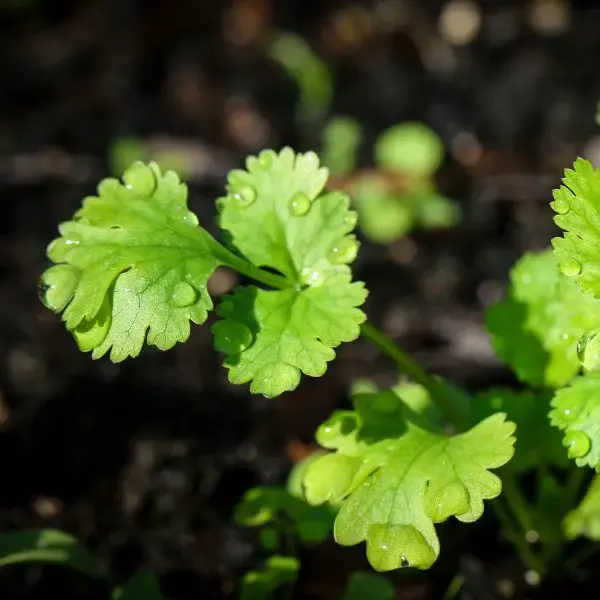
- Botanical name: Coriandrum sativum
- Sun Requirements: Full sun
- Soil Type: Light, well-drained soil, with organic matter
If you like cooking authentic Mexican dishes, then cilantro really is a must-have in your garden. Authentic dishes simply don’t taste the same without it! What you might not know about this herb, however, is that it makes an excellent garden-mate for your peas.
Cilantro is a cool season plant and it will appreciate the nitrogen that your peas will be giving it to help it grow. It is also said to improve the taste of your peas and while we cannot verify this claim, we CAN say that the cilantro will help to repel potato beetles, flies, spider moths, and aphids. This makes cilantro and peas quite the adequate pairing, we think, and well-worth a try in your garden.
3. Sweet Alyssum
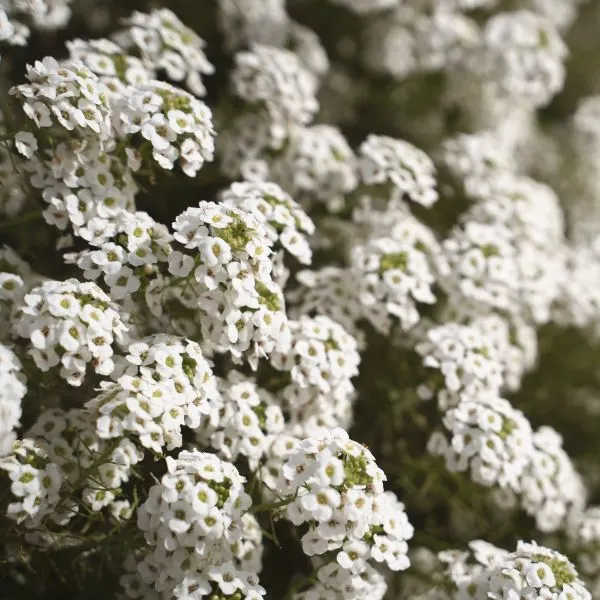
- Botanical name: Lobularia maritima
- Sun Requirements: Full sun to partial shade
- Soil Type: Well-drained soil, pH 6.0 to 7.0
Edible and also considered medicinal, Sweet Alyssum does well in the cool season and makes an excellent plot-partner with your peas. The reason for this has to do with the pests that normally get into peas – aphids, spider mites, and thrips are good examples.
When planted next to peas, eventually your Sweet Alyssum flowers will attract lots of beneficial bugs, such as parasitic wasps, hoverflies, green lacewings, and everyone’s favorite – ladybugs! These beneficial bugs will help to make short work of the pests that would otherwise eat up your peas and the Sweet Alyssum won’t compete with or even need anything in return.
4. Basil
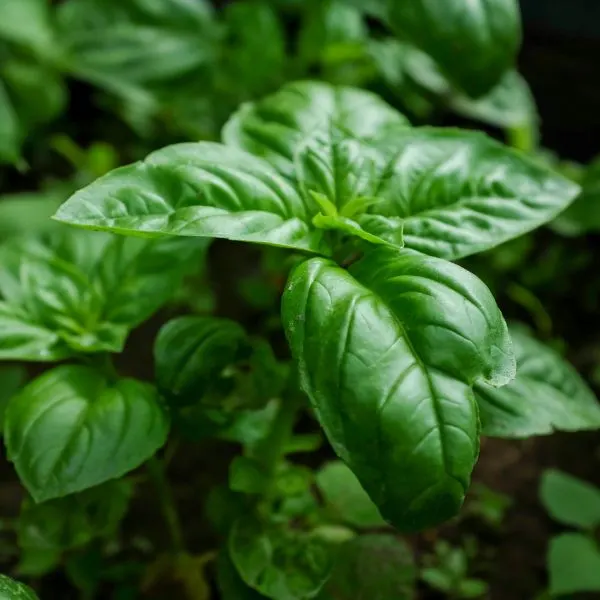
- Botanical name: Ocimum basilicum
- Sun Requirements: Full sun
- Soil Type: Fertile, well-drained, and loamy soil
A vital ingredient in many Mediterranean and Asian culinary delights, Basil is another herbal staple to be found in many gardens around the world. As it turns out, it can be grown with your peas and the two will have a nice, symbiotic relationship from which both will benefit.
On the Basil’s side, the nitrogen from the peas will help to induce and sustain rapid growth of the basil’s leaves, while the scent of the basil will help to keep thrips away from your peas. It’s a simple exchange that is good for both plants, making this match a pairing with some potential!
Healthy Veggies and Delicious fruits
5. Potatoes
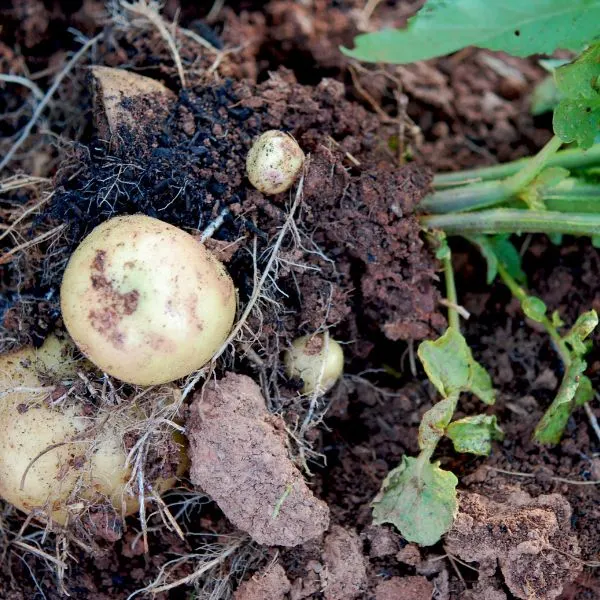
- Botanical name: Solanum tuberosum
- Sun Requirements: Full sun (can handle partial shade)
- Soil Type: Well-drained, sandy soil
Potatoes may be grown with peas if that’s what you fancy and it’s really good for the soil. While potatoes do like a nip of nitrogen every now and again, they’re more concerned with phosphorus and potassium, and they’ll loosen up the soil nicely where they are grown to the benefit of your peas and whatever else you may decide to plant there later.
The peas, on their part, will help to add nitrogen to that soil, so that over time its quality is going to be greatly improved by the simple act of pairing your peas with your potatoes!
6. Beans

- Botanical name: Phaseolus vulgaris L.
- Sun Requirements: Full sun
- Soil Type: Well-drained clay loam
Beans and peas can make great roomies and as they have similar requirements, it’s a pairing that’s easy to take care of. Much like planting potatoes with peas, these plants are a good match together for improving the overall quality of the soil. As they will both add nitrogen to it, you can plant one or more companions eventually that can make good use of it.
Some folks will grow these together by setting up an a-frame trellis, planting the peas first in the spring and affixing them to their side, and later planting the beans for the other side of the trellis. It’s a nice look and a friendly companion plant option if you’d like to grow both peas and beans in your garden!
7. Beets
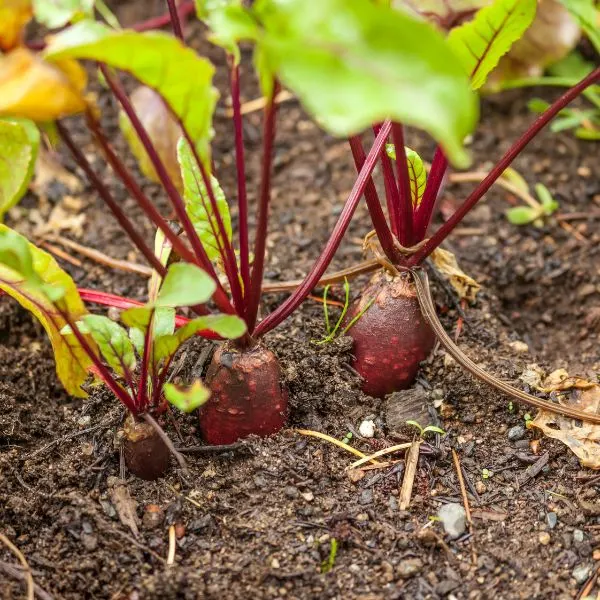
- Botanical name: Beta vulgaris
- Sun Requirements: Full sun (or some light shade)
- Soil Type: Light or loamy soil, or clay with added compost
If you are already growing beets in your garden or simply like the idea, then you can save yourself a little on fertilizer by planting your beets with your peas. Both plants like the cool weather and if you whip up a trellis for your peas, then the pods will be easier to get at and you can flank it on both sides with rows of your beets.
Be sure to give them a little space, however, as both plants are quite susceptible to fungus so just be sure to give them at least 6 inches of space or a little more so that you won’t be raising the risks of fungus. As long as you do this, these two will grow well together like the best of friends!
8. Corn
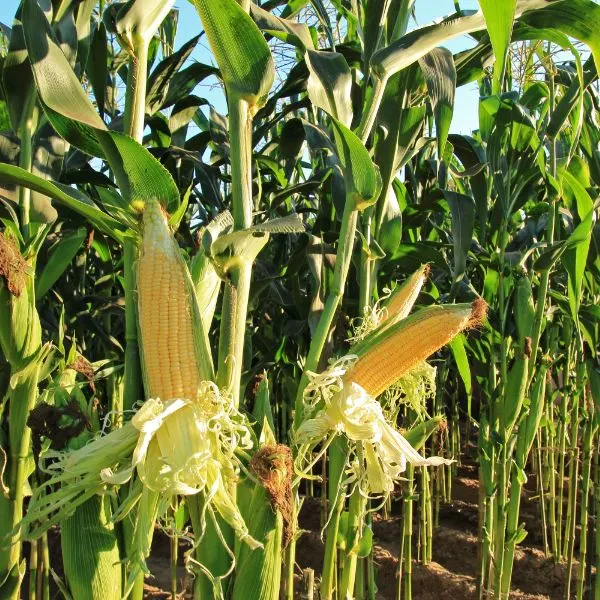
- Botanical name: Zea mays
- Sun Requirements: Full sun
- Soil Type: Loamy soil with lots of nitrogen
Corn and peas will get along like gangbusters in your garden and if you haven’t tried this pairing before, then we heartily recommend it. Those tall corn stalks will help to give your peas a little shade from time to time, but what’s cooler is that you can also use them as a living trellis if you like!
While it’s lending your peas a helping hand, they’ll be returning the favor by introducing more nitrogen in the soil, which your corn will be sure to put to good use. It’s an excellent pairing and one to consider when you are planning out your next plantings.
9. Cucumbers

- Botanical name: Cucumis sativus
- Sun Requirements: Full sun
- Soil Type: Fertile, loose, and well-drained soil
While there aren’t a whole lot of perks to it, you can certainly grow cucumbers with your peas and the two will get along quite well together. Cucumbers, on their part, will loosen up the soil a bit for your peas and the nitrogen the peas are producing is good for the cukes, as they have moderate nitrogen requirements.
Just be careful with fertilizer so that you don’t overdo it – too MUCH nitrogen can cause your cucumbers to flower late but as long as it’s kept at moderate levels, the cukes will get along well with your peas.
10. Spinach

- Botanical name: Spinacia oleracea
- Sun Requirements: Full sun (will tolerate partial shade)
- Soil Type: Moisture retentive, well-drained, and nitrogen-rich soil
Spinach and peas make good neighbors in your garden, although the merits are fairly mild. As these two are both fine with colder weather and won’t compete for resources, we’re already off to a good start, but the biggest bonus of having these two together is the extra nitrogen from the peas that will help your spinach to grow up strong.
Just keep in mind that the peas won’t be a replacement for fertilizer – they will definitely help and you’ll be able to use less, but some fertilizer is still recommended so that your spinach will be at its best.
11. Carrots
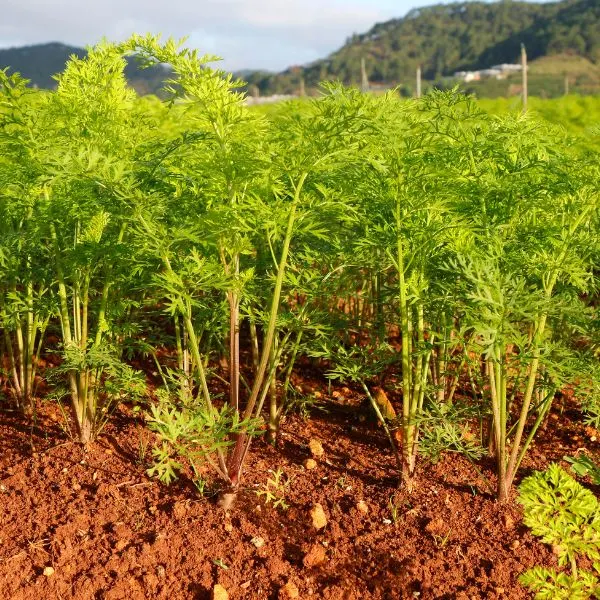
- Botanical name: Daucus carota subsp. sativus
- Sun Requirements: Full sun
- Soil Type: Sandy loam
Carrots and peas make an excellent match if you take the time to plant them together in the summer for a fall harvest. These two go well together, since they will not fight over resources, and both will be improving the soil – the carrots by loosening it up as they grow and when they are harvested, and the peas by adding in their signature nitrogen spike to improve its overall quality.
Both plants are hardy so that a light frost won’t be a problem for either, just remember that carrots only need light nitrogen so that you don’t overdo it by adding fertilizer to the little plot in your garden that they are sharing.
12. Celery
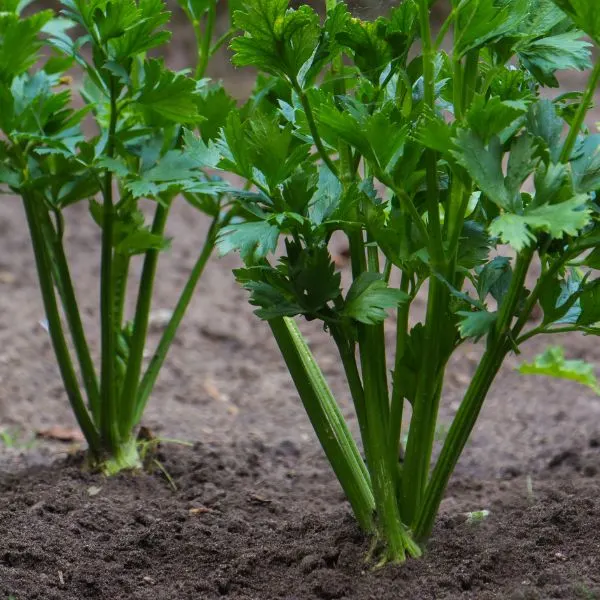
- Botanical name: Apium graveolens
- Sun Requirements: Full sun
- Soil Type: Loose, well-drained, organic-rich soil
Celery is another great companion planting choice for growing with your peas, and it’s a relationship that will benefit the both of them. For the celery, the nitrogen that the peas have brought to the party will help the plant to grow up healthy and strong, while the peas will benefit from the repelling power of the celery, as well.
Celery acts as a deterrent to whiteflies, who might well otherwise get into your peas and make problems. It’s simple, symbiotic, and an excellent companion plant relationship that you’ll appreciate come harvest time.
Ornamental additions
13. Nasturtium
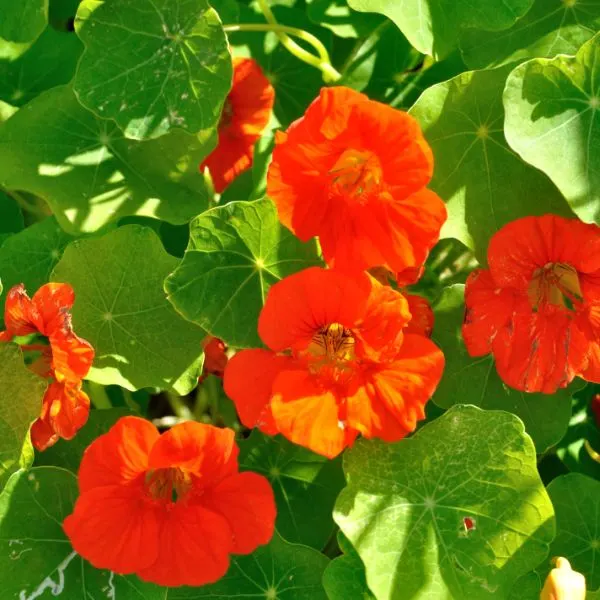
- Botanical name: Tropaeolum majus
- Sun Requirements: Full sun
- Soil Type: Fertile, well-drained soil
Nasturtium makes a great garden-buddy for your peas and its contribution is to act as a ‘trap plant’. You see, aside from providing those brilliant orange blooms and attracting pollinators and useful insects, Nasturtium is a plant that is fully edible to humans, most animals, and to the aphids that love eating the stuff!
So, by planting Nasturtium next to your pea, the aphids that would normally plague them will actually go after the more desirable and edible ornamental plant. Just be sure not to add any extra nitrogen to the soil via fertilizer, as too much will mean that you’ll get less flowers from your Nasturtium. Provided that you do this, both plants should get along like gangbusters!
14. Cosmos
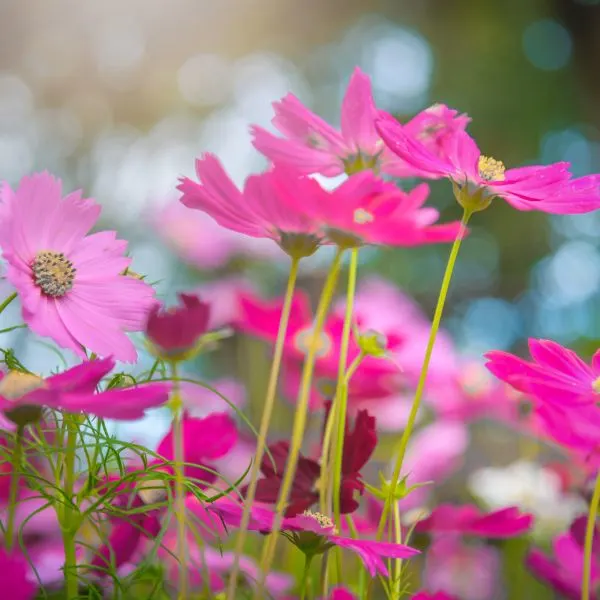
- Botanical name: Cosmos sulphureus
- Sun Requirements: Full sun (or partial shade in warmer climes)
- Soil Type: Chalky, sandy, or loamy soils
Cosmos are beautiful and even have some minor repellent properties when it comes to corn earworm. Planted with your peas, they can add some nice aesthetics, and they will also attract butterflies and bees in the bargain. Available in varieties that sport purple, pink, chocolate, white, red, yellow, or orange flowers, you’ve definitely got a lot of color coordination options and these plants are extremely easy to maintain.
As with Nasturtium, avoid adding any extra fertilizer that contains nitrogen – too much of it can make your Cosmos have rather spindly leaves. Cosmos and peas don’t have a whole lot of benefits beyond this,, although the aesthetics and the fact that they won’t fight over resources still make them a pretty good pair.
15. Marigolds
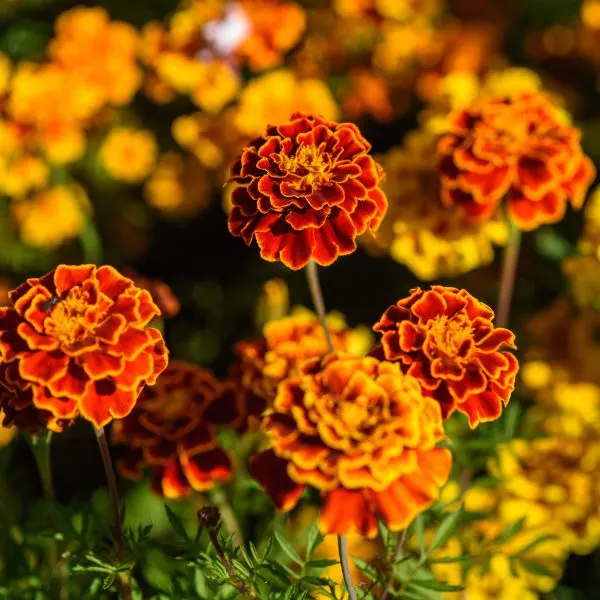
- Botanical name: Tagetes
- Sun Requirements: Full sun
- Soil Type: Well-drained, Loamy soil
Marigolds can add a little color to your garden and if you grow them with your peas, they bring an extra perk to the table in the pests that they will repel. Marigolds can help to keep away nematodes, Mexican bean beetles, Cabbage worms, and more, which is a pretty nice perk for an ornamental selection.
The peas will show their thanks in the form of the nitrogen they’ll share, which will help the Marigolds to grow up happy, healthy, and strong. Overall, it’s a pretty match and also a quite useful one, so consider adding Marigolds to your pea-patch sometime to see what you think – they really get along quite well!
Bad Companion plant for peas
Now that we’ve explored some of the good companion plants for peas, it’s time to flip the coin and take a look at a few that you’ll definitely want to keep far away. Each of the selections below should be considered a poor fit for planting with your peas and we’ll tell you the ‘why’ of it in the descriptions that follow. Let’s take a look!
1. Chives
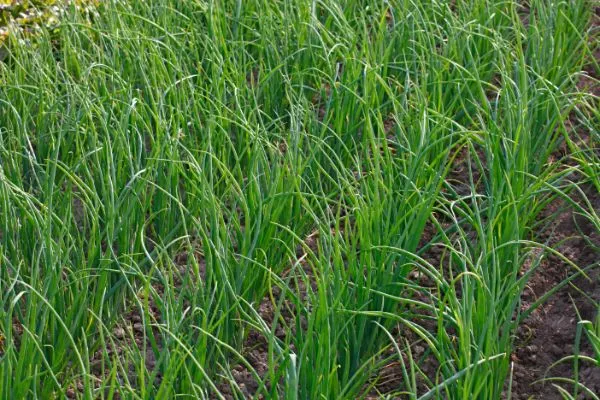
Chives are sharp, delicious, and best kept at a distance from your peas. That’s because chives have a chemical called ajoene, which works wonders in keeping away fungus, but which also gets into the soil. As a result, it can affect the growth of your peas and actually stunt them so that they won’t properly grow. You’ll still get peas eventually, but the ajoene from the chives will make them grow slowly and will likely affect how the pea plant looks and how it tastes. It’s better to simply keep these two apart!
2. Peppers
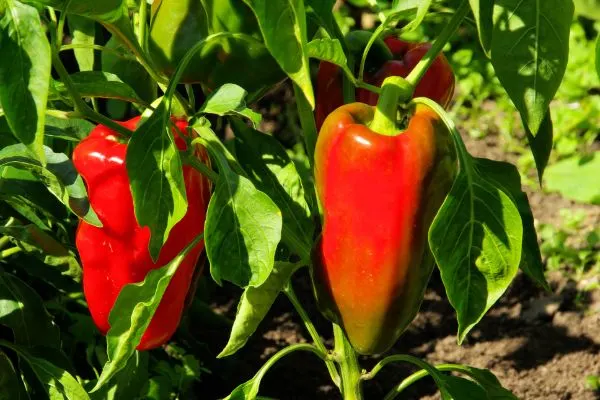
Peas are cool weather plants, while peppers are all about the summer. As such, they don’t really make good companions – at best, you would be trimming the peas after harvest in order for the peppers to grow up and fill their space. On the same token, when it gets chilly, your peppers won’t do well, while your peas are going to thrive.
So, while the plants won’t adversely affect each other (the peppers might drive away some pests, for instance), planting them together is more of a ‘timeshare’ scenario on the space, rather than a true companion planting, so you’re better off pairing peas with something more compatible.
3. Garlic
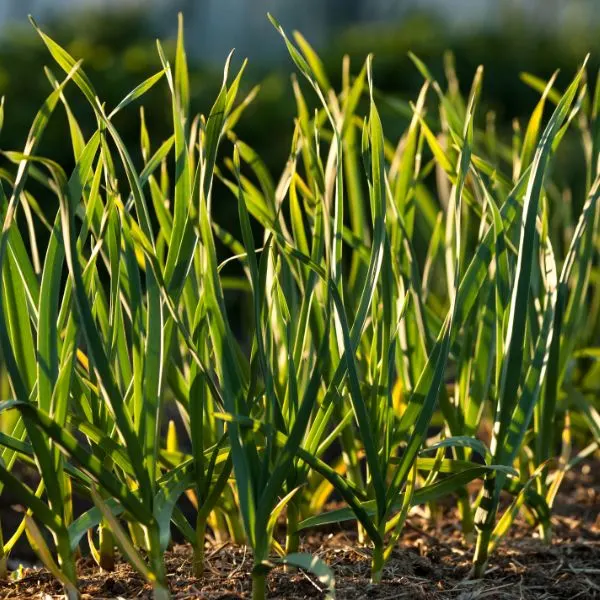
Garlic and peas hang out sometimes in your kitchen or more specifically, on your plate, but in the garden they don’t make good companion plants. As with chives, the ajoene that they produce will stunt the growth of your peas and while they won’t die, they will struggle if they are planted too close to garlic and you’ll get a poor yield and a sickly looking plant.
4. Tomatoes
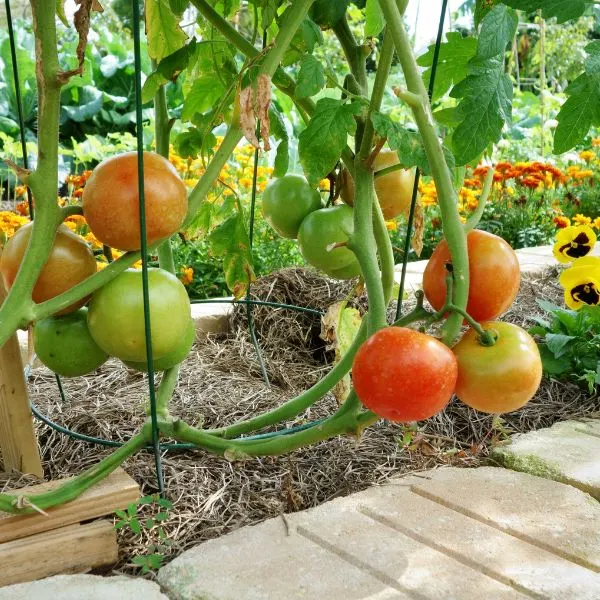
To be clear, you CAN make tomatoes and peas grow together, but it’s not the best scenario and you’ll be adding a lot of work raising them together that you could definitely put to better use elsewhere. Starting off, tomatoes are children of the summer, while peas prefer to stay ‘chill’ and thrive when it’s cool.
Secondly, there’s the matter of trellising – peas are easier to harvest with a trellis and tomatoes flat-out need them for proper support, and what you get when you grow them together is probing vines that might well get tangled easily when you’re not looking.
It’s better to just keep them separated so that you don’t end up with two favorite plants that are essentially tied up in knots!
5. Scallions
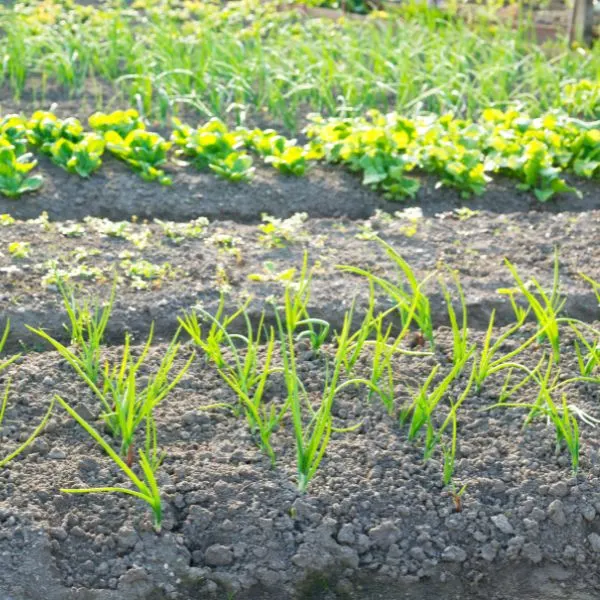
Garlic, chives, and scallions are all members of the allium family and that ajoene that we’ve mentioned comes into play again if you plant them too close to your peas. Your peas will grow up sickly, the yield won’t be generous, and you’ll definitely wish that you’d picked another partner for your peas. Save yourself the trouble and keep these two separated for their own good!
FAQs
We’ve just about run out of our allotted space for today, but in hopes of being useful in your new companion planting explorations, we’re including a few frequently asked questions on the subject. Let’s take a look and if you find something useful, then be sure to hang onto it and put it to some good use!
What are some other plants that grow well with sweet peas?
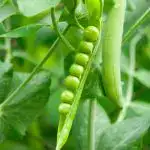
There are certainly quite a few more plants that will grow well with your sweet peas, with a few examples including parsley, eggplants, and strawberries. With strawberries, you’ll even get bigger berries as they do pretty well with the nitrogen-packed punch that your peas will bring to the soil, but all of these examples will do really well with your sweet peas!
Do peas need a trellis when companion planting?
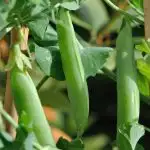
While they don’t technically need one, a trellis is a good idea when you are companion planting with peas and even in general. A trellis makes them easy to harvest, for one thing, but as far as with companions, it also helps to ensure that their chosen companion plant doesn’t give them too much shade. With that trellis, they should still get plenty of sunshine, and so you shouldn’t have any problems there.
Can I grow onions with my peas?

You could, but we wouldn’t recommend it. Onions and just about any other alliums are likely to stunt the growth of your peas and so it’s better to keep them far away from each other. They simply don’t do very well together at ALL.
Wrapping-up on companion plants for peas
Today we’ve taken a look at the best (and some of the worst) companion plants for peas and we hope that we’ve piqued your curiosity on companion planting in the process. Strategically choosing your plant’s neighbors is a great way to take advantage of the soil perks, natural defenses, and other bonuses that they can bring to the table.
Just be sure to avoid alliums that could stunt your peas growth and consider a trellis when you perform your own companion planting experiments to make sure that your peas are getting as much sunlight as possible. When harvest time comes, if you like what you see, then why not try adding a third plant to the party?
The combinations are almost endless and the results can really be out of this world!
More companion plants
